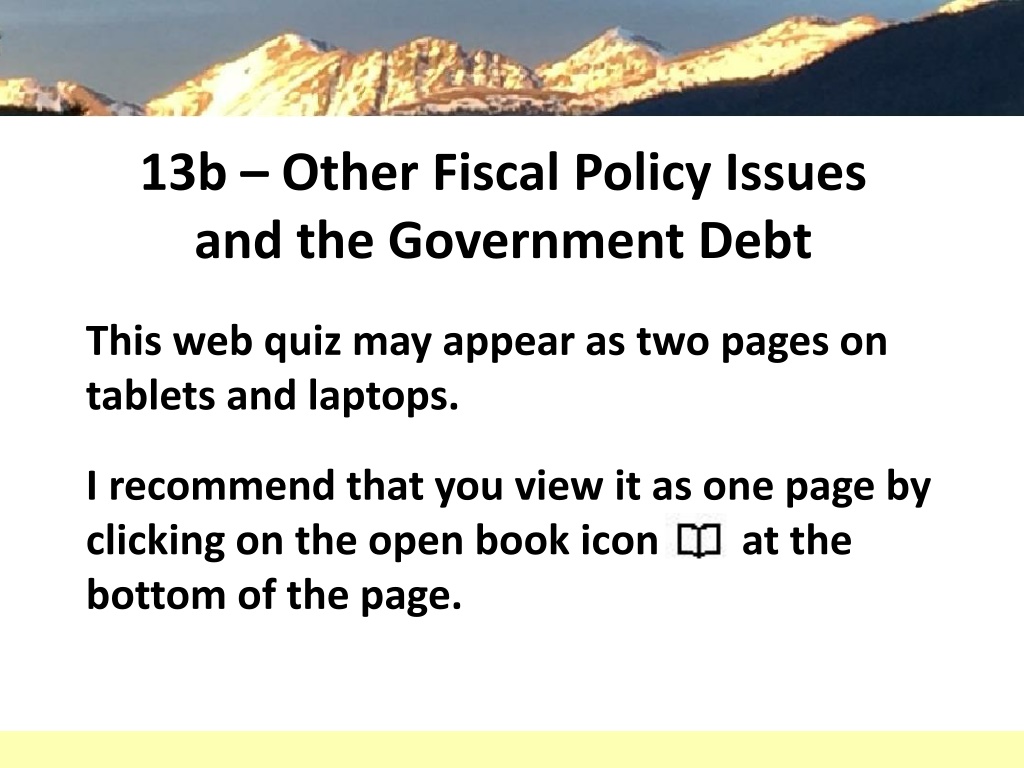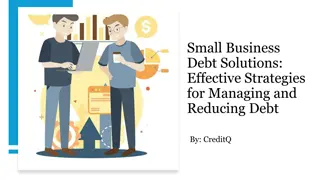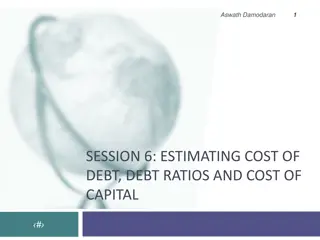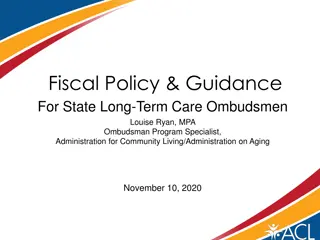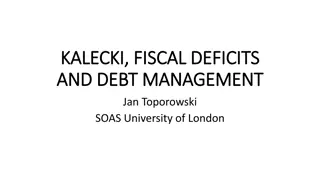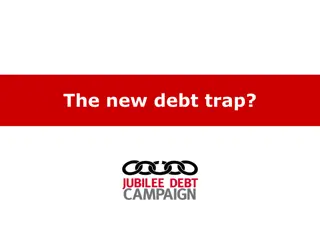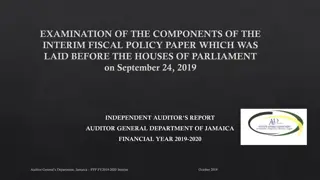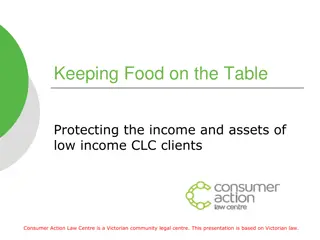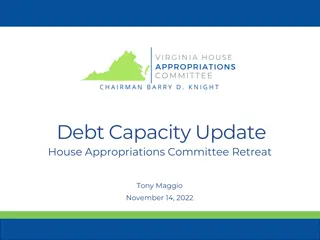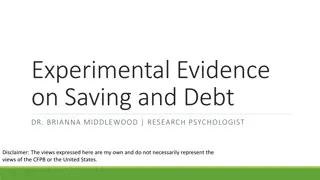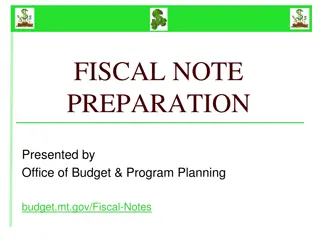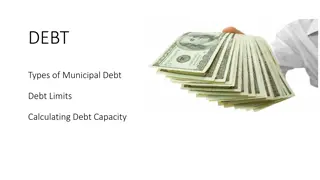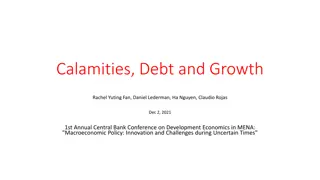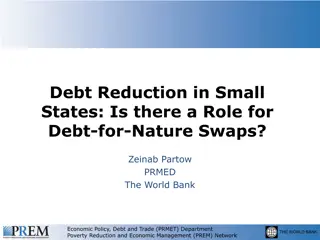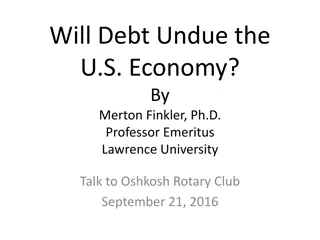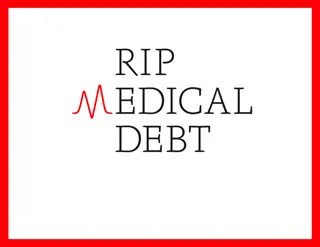Understanding Fiscal Policy Issues and the Government Debt
Explore the causes of the Great Depression, differing views on fiscal policy, impacts of budget deficits on trade deficits, and key issues related to government debt. Learn about public debt concerns, effects of Social Security and Medicare programs, and debates on balanced budget amendments. Delve into key terms like New Keynesian, New Classical, Glass-Steagall, and more.
Download Presentation

Please find below an Image/Link to download the presentation.
The content on the website is provided AS IS for your information and personal use only. It may not be sold, licensed, or shared on other websites without obtaining consent from the author. Download presentation by click this link. If you encounter any issues during the download, it is possible that the publisher has removed the file from their server.
E N D
Presentation Transcript
13b Other Fiscal Policy Issues and the Government Debt This web quiz may appear as two pages on tablets and laptops. I recommend that you view it as one page by clicking on the open book icon at the bottom of the page.
13b Other Fiscal Policy Issues and the Debt Other FP Issues Policy in the Great Depression New Keynesian and New Classical FP Government Budget Deficits and Trade The Federal Deficits and Debt Facts False Concerns Substantive Issues
13b Other Fiscal Policy Issues and the Debt Outcomes / Must Know - 1: - Discuss the causes of, and the government reaction to, the Great Depression. - Explain the differences between the New Keynesian view of fiscal policy and the New Classical view
13b The Debt Outcomes / Must Know - 2: Discuss the causes and government reaction to the Great Depression. Explain the differences between the New Keynesian view of fiscal policy and the New Classical view How does a budget deficit affect the trade deficit? Vice President Walter Mondale in 1984 was running for president against President Ronald Reagan. During a debate he was asked what he would do about the large trade deficit of the time. His answer was that to reduce the trade deficit we need to reduce the budget deficit and he would raise taxes to do that. He was not elected president, but explain his argument. Differentiate between the deficit and the debt. State the relative size of the debt as a percentage of GDP and describe how that has changed in recent years. Describe the annual interest charges on the debt, who holds the debt, and the impact of inflation on the debt. Explain why the debt can also be considered public credit. Identify and discuss two widely held "False Concerns" about the public debt. Explain the "Substantive Issues" of the public debt including: income distribution, economic incentives, the foreign owned debt, crowding out, and public investments. What effects might the Social Security and Medicare programs have on the public debt? The Glass-Steagall Act has been repealed, income inequality is increasing, and the stock market is near an all-time high. Are we in danger of another great depression? Will the public debt bankrupt the United States' government? What effect would a constitutional amendment requiring the federal government balance its budget have on the effectiveness of fiscal policy? Hint: procyclical
13b Other Fiscal Policy Issues and the Debt KEY TERMS: New Keynesian, New Classical, Glass-Steagall, Smoot-Hawley Tariff Act, U.S. Securities, public deficits, public debt, public debt held by the public, intragovernmental debt, external public debt, crowding out, public investments, public-private complementarity, efficiency wage
1. According to the video which of the following was NOT a cause of the Great Depression (1929-1933)? 1. Unequal distribution of wealth 2. People borrowed money to buy stocks 3. A decrease in government spending 4. The stock market crash of 1929 NOTE: there is not complete agreement among economists on what caused the Great Depression Policy in the Great Depression
1. According to the video which of the following was NOT a cause of the Great Depression (1929-1933)? 1. Unequal distribution of wealth 2. People borrowed money to buy stocks 3. A decrease in government spending 4. The stock market crash of 1929 NOTE: there is not complete agreement among economists on what caused the Great Depression Policy in the Great Depression
2. During the early part of the Great Depression UE increased. What did the government do? 1. Cut taxes 2. Raised taxes 3. Restricted trade 4. Decreased the MS 5. 2, 3, and 4 above Policy in the Great Depression
2. During the early part of the Great Depression UE increased. What did the government do? 1. Cut taxes 2. Raised taxes 3. Restricted trade 4. Decreased the MS 5. 2, 3, and 4 above Policy in the Great Depression
Policy in the Great Depression
3. Which of these did NOT contribute to ending the Great Depression? 1. FDR s New Deal spending programs 2. WWII 3. Raising taxes to pay for WWII 4. Unemployment insurance NOTE: there is not complete agreement among economists on what ended the Great Depression Policy in the Great Depression
3. Which of these did NOT contribute to ending the Great Depression? 1. FDR s New Deal spending programs 2. WWII 3. Raising taxes to pay for WWII 4. Unemployment insurance NOTE: there is not complete agreement among economists on what ended the Great Depression Policy in the Great Depression
In 1932, Franklin D. Roosevelt was elected President based on his promises to create Federal Government programs to end the Great Depression. Within 100 days the New Deal was signed into law. This created 42 new agencies designed to create jobs, allow unionization, and provide unemployment insurance. Many of these programs, such as Social Security, the SEC (Securities and Exchange Commission), and FDIC (Federal Deposit Insurance Corporation) are still here today, helping to safeguard the economy.
The Glass-Steagall Act - 1 Passed in 1933 as the Banking Act, prohibited commercial banks from participating in the investment banking business. The Act was passed as an emergency measure to counter the failure of almost 5,000 banks during the Great Depression. The Glass-Steagall lost its potency in subsequent decades and was finally repealed in 1999.
The Glass-Steagall Act - 2 Many commentators have stated that the repeal of the Glass Steagall Act was an important cause of the late-2000s financial crisis. Some critics of that repeal argue it permitted Wall Street investment banking firms to gamble with their depositors' money that was held in affiliated commercial banks.
The Glass-Steagall Act - 3 Others have argued that the activities linked to the financial crisis were not prohibited (or, in most cases, even regulated) by the Glass Steagall Act. Commentators, including former President Clinton in 2008 and the American Bankers Association in January 2010, have also argued that the ability of commercial banking firms to acquire securities firms (and of securities firms to convert into bank holding companies) helped mitigate the financial crisis.
4. What is the likely effect of an increase in government spending if prices and wages are very flexible? 1. Both output and prices will rise. 2. Output will rise, and prices will remain unchanged 3. Both output and prices will fall. 4. Prices will rise, and output will remain unchanged. New Keynesian and New Classical FP
4. What is the likely effect of an increase in government spending if prices and wages are very flexible? 1. Both output and prices will rise. 2. Output will rise, and prices will remain unchanged 3. Both output and prices will fall. 4. Prices will rise, and output will remain unchanged. New Keynesian and New Classical FP
New Keynesian and New Classical FP
5. According to New Keynesians, fiscal policy can have an effect on output because of which of the following factors? 1. Wages are sticky. 2. Prices adjust instantly. 3. Producers cut back production when faced with rising prices 4. People save more when government spending increases. New Keynesian and New Classical FP
5. According to New Keynesians, fiscal policy can have an effect on output because of which of the following factors? 1. Wages are sticky. 2. Prices adjust instantly. 3. Producers cut back production when faced with rising prices 4. People save more when government spending increases. New Keynesian and New Classical FP
New Keynesian and New Classical FP
New Keynesian and New Classical FP
6. Which is NOT one of the reason, believed by the Mainstream economists, why wages are sticky downwards ? 1. Wage Contracts 2. Minimum Wage 3. Efficiency Wage 4. Wages Limits Why might wages be sticky downwards ? New Keynesian View
6. Which is NOT one of the reason, believed by the Mainstream economists, why wages are sticky downwards ? 1. Wage Contracts 2. Minimum Wage 3. Efficiency Wage 4. Wages Limits Why might wages be sticky downwards ? New Keynesian View
Efficiency Wages: How can a higher wage result in greater efficiency? Greater work effort The above-market wage, in effect, raises the cost to workers of losing their jobs as a result of poor performance. Because workers have a strong incentive to retain their relatively high-paying jobs, they are more likely to provide greater work effort. Looked at differently, workers are more reluctant to shirk (neglect or avoid work) because the higher wage makes job loss more costly to them. Consequently, the above-market wage can be the efficient wage; it can enhance worker productivity so much that the higher wage more than pays for itself. Lower supervision costs With less incentive among workers to shirk, the firm needs fewer supervisory personnel to monitor work performance. This, too, can lower the firm's overall wage cost per unit of output. Reduced job turnover The above-market pay discourages workers from voluntarily leaving their jobs. The lower turnover rate reduces the firm's cost of hiring and training workers. It also gives the firm a more experienced, more productive workforce. Why might wages be sticky downwards ? New Keynesian View
How can a higher wage result in greater efficiency? The key implication for macroeconomic instability is that efficiency wages add to the downward inflexibility of wages. Firms that pay efficiency wages will be reluctant to cut wages when aggregate demand declines, since such cuts may encourage shirking, require more supervisory personnel, and increase turnover. In other words, wage cuts that reduce productivity and raise per- unit labor costs are self-defeating. Why might wages be sticky downwards ? New Keynesian View
If wages are inflexible downwards: A decrease in AD will not cause lower wages and therefore will not cause a quick increase in AS And will not return the economy to full employment. Why might wages be sticky downwards ? New Keynesian View
If wages are inflexible downwards: A decrease in AD will not cause lower wages and therefore will not cause a quick increase in AS And will not return the economy to full employment. Why might wages be sticky downwards ? New Keynesian View
7. Expansionary FP can lead to budget deficits. How do budget deficits affect trade? 1. Budget deficits cause lower interest rates and the $ depreciates 2. Budget deficits cause lower interest rates and the $ appreciates 3. Budget deficits cause higher interest rates and the $ depreciates 4. Budget deficits cause higher interest rates and the $ appreciates Government Budget Deficits and Trade
7. Expansionary FP can lead to budget deficits. How do budget deficits affect trade? 1. Budget deficits cause lower interest rates and the $ depreciates 2. Budget deficits cause lower interest rates and the $ appreciates 3. Budget deficits cause higher interest rates and the $ depreciates 4. Budget deficits cause higher interest rates and the $ appreciates Government Budget Deficits and Trade
Vice President Walter Mondale in 1984 was running for president against President Ronald Reagan. During a debate he was asked what he would do about the large trade deficit of the time. His answer was that to reduce the trade deficit we need to reduce the budget deficit and he would raise taxes to do that. Government Budget Deficits and Trade
8. What is the approximate size of the U.S government debt (public debt)? 1. $ 5 trillion 2. $ 8 trillion 3. $ 15 trillion 4. $ 21 trillion 5. $ 25 trillion http://www.usdebtclock.org/ Federal Deficits and Debt: Facts
8. What is the approximate size of the U.S government debt (public debt)? 1. $ 5 trillion 2. $ 8 trillion 3. $ 15 trillion 4. $ 21 trillion 5. $ 25 trillion http://www.usdebtclock.org/ Federal Deficits and Debt: Facts
2012: Total debt held outside the federal govt= 60% 33% foreign owned (China owns about a quarter, Japan a fifth) 10% owned by banks, etc. 6% owned by US individuals 11% Other including state and local gov/t 2012: Debt held within the federal gov t* = 40% 29% US government agencies 11% Federal Reserve *government securities held by government trust funds, such as the Social Security trust fund and the Medicare trust fund, and the Federal Reserve Federal Deficits and Debt: Facts
2009 Federal Deficits and Debt: Facts
2015 Federal Deficits and Debt: Facts
9. Who is more in debt, a person with what income and what debt? 1. Income = $1,000,000; debt = $500,000 2. Income = $100,000; debt = $50,000 3. Income = $10,000; debt = $5,000 4. Income = $10,000; debt = $8,000 Federal Deficits and Debt: Facts
9. Who is more in debt, a person with what income and what debt? 1. Income = $1,000,000; debt = $500,000 2. Income = $100,000; debt = $50,000 3. Income = $10,000; debt = $5,000 4. Income = $10,000; debt = $8,000 Federal Deficits and Debt: Facts
U.S. Total Debt as a Percent of GDP Federal Deficits and Debt: Facts
U.S. Debt Held by Public as a Percent of GDP Federal Deficits and Debt: Facts
Government Debt as a % of GDP United States http://visual.ly/united-states-debt-percentage-gdp-1940-2012 Other Countries http://www.nationmaster.com/country-info/stats/Economy/Debt/Government-debt/Gross-government-debt-as-%25-of-GDP Federal Deficits and Debt: Facts
10. Which of the following are False concerns regarding the public debt? 1. Income distribution and crowding-out 2. Gov t bankruptcy and burden on future generations 3. Distortion of incentives and debt owned to foreigners 4. Public investment and public-private complementarities Federal Deficits and Debt: False Concerns
10. Which of the following are False concerns regarding the public debt? 1. Income distribution and crowding-out 2. Gov t bankruptcy and burden on future generations 3. Distortion of incentives and debt owned to foreigners 4. Public investment and public-private complementarities Federal Deficits and Debt: False Concerns
11. Which is NOT a substantive issue concerning the large federal government debt? 1. The debt held by U.S. citizens 2. Income distribution 3. incentives 4. Foreign-owned public debt 5. Crowding out effect Federal Deficits and Debt: Substantive Issues
11. Which is NOT a substantive issue concerning the large federal government debt? 1. The debt held by the U.S. citizens 2. Income distribution 3. incentives 4. Foreign-owned public debt 5. Crowding out effect Federal Deficits and Debt: Substantive Issues
